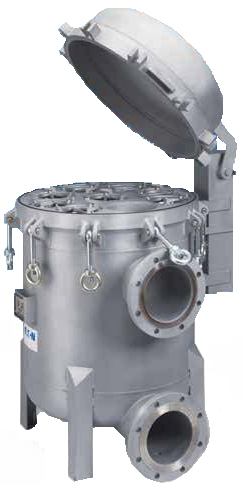PROLINE BAG FILTER HOUSINGS
Economical multiple bag filter housings for high flow rate applications

PROLINE bag filter vessels are an "economy" version of the MAXILINE bag filter housing, our article PROLINE vs MAXILINE compares both designs in detail.
The "economy" aspect of PROLINE bag filter housings arises from its investment cast components: the dished heads (top & bottom) and tube sheet. Modern casting techniques result in a lighter weight and reduced cost when compared to manufactured components. Creation and maintenance of such castings is expensive, however these costs are amortized over many units whereas the related costs for conventionally welded designs have an inherently higher cost for each unit. Another advantage of using cast components is reduction of lead time because they are less labor intensive to manufacture. The tube sheet is the multi-hole structure where the restrainer (support)baskets are installed and it is responsible for directing the liquid into the filter bags. A cast tube sheet is much less expensive than a fabricated one as it does not require welding and all of the related NDE procedures.
A potential downside to the PROLINE bag filter housing is that they cannot be ASME code stamped. Due to the cast components used in its construction, ASME code is not applicable, so if your system requires an ASME code stamp you would need to use the MAXILINE bag filter housing design.
What is the difference between a non-code and ASME code pressure vessel?
ASME code pressure vessels are built to the requirements of ASME boiler and pressure vessel code and is oftentimes a requirement for certain types of applications. The safety factor incorporated into an ASME code design is 3.5 : 1 whereas a non-code vessel may be less, for example 3 : 1. All of the welders must be qualified in accordance with ASME section IX and a non-code vessel can be fabricated by persons experienced in pressure vessel fabrication. An ASME code vessel is physically inspected and relevant documentation reviewed by an independent 3rd party prior to receiving a stamp and being registered with the National Board - there is no such requirement for non-code vessels. Since most applications do not have an ASME code stamp requirement, the PROLINE bag filter housing offers a significant cost savings for the most common applications.
While the PROLINE and MAXILINE bag filter housings each have the ASME 150 PSI pressure rating, the PROLINE bag filter housing is limited to 200F whereas the MAXILINE can handle temperatures up to 250F.
If your filtration requirement falls within 1 to 100 microns (nominal), also consider the HAYFLOW upgrade option, as it may reduce the number of bag filter stations required.
PROLINE Documentation:
PROLINE 150 HE Datasheet, PROLINE 150 IOM
Outline Drawings:




